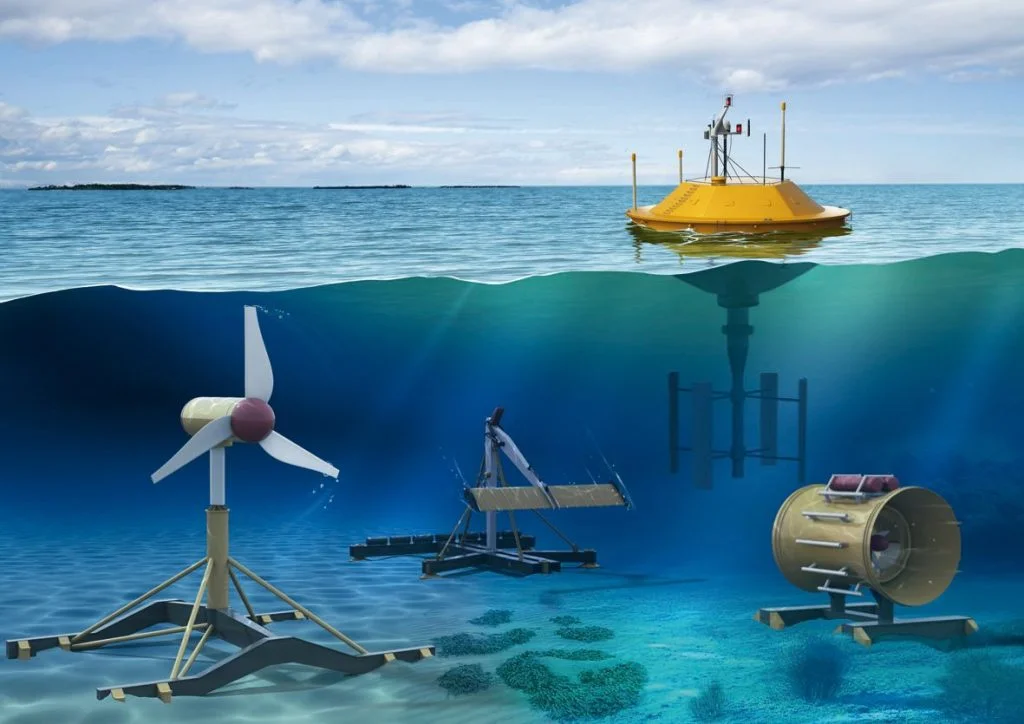Marine energy can be harnessed by waves, tides, and river and ocean currents. Not only that, but it can also be harnessed from temperature differences in water through thermal energy conversion. Total available marine energy resource in the U.S. is equivalent to about 57% of all U.S. power generation as of 2019. Even if only a small portion of this potential resource was captured, it would make significant contributions to the nation's energy needs. Researchers continue their work to harness energy from our plentiful water resources.
Marine energy uses kinetic energy from waves, currents, tides, and thermal energy of deep cold water to surface water conversion to create clean energy. Marine energy developers are building a diverse fleet of machines to obtain this power. Some examples include: paddles that sway like a beaver tail or ripple like a sea snake, sitting on the waters surface, hovering on the sea floor, or spinning like mini underwater wind turbines. They come in all shapes and sizes and are still being tested for maximum efficiency.
These powerful water sources are everywhere. Alaska's Cook Inlet possesses currents that can stream in and out at 9 miles per hour. This is one of the Earth's greatest tidal energy resources. The inlet is capable of providing enough energy to power 7.5 million homes. Many of the U.S.'s coastal communities hold the potential to be marine energy powerhouses.
The U.S. Department of Energy's Water Power Technologies Office is funding research towards responsibly deploying marine energy devices into the ocean where they can coexist with marine life and ecosystems. The WPTO states that their top priority is studying the interactions of the equipment with wildlife and to recognize potential changes in natural environment conditions and the safety of marine life.
There are an abundance of benefits regarding hydrokinetic energy, however, the energy itself can be a challenge to harness. Unlike solar or wind power, when the sun sets and the wind slows, oceans and rivers keep powering on! The biggest struggle regarding this natural resource is just how powerful it is. Salt water can damage ocean-bound machines and waves crash with insanely strong force, which gets costly when needing to repair and maintain these resources.
As time rolls on and struggles persist, companies are still successfully deploying prototypes and conducting research to make this clean power source work. Marine energy could be a turning point for climate change and implements the beautiful power of our ocean's energy.







This is seriously a well written post. It is obvious how much research and thought you put into this. Good Job! I have heard very briefly about water or wave power, but not to this extent. I wonder if it would work in lakes or if this is just an ocean thing.
ReplyDeleteIt works in rivers and bodies of water with a strong tide. I think the great lakes would be perfect for this kind of thing!
DeleteThis is pretty cool, and it seems like it wouldn't come with the same drawbacks to ecosystems that hydroelectric power comes with! It seems like an obvious choice to use the movement of ocean currents or the tides to generate power, it's kinda strange how I've never heard of it before.
ReplyDeleteExciting and important source of renewable energy. We don't need fossil fuels!!
ReplyDeleteOther example of why fossil fuel are outdated. I have never heard about this technology and it seems perfect for remote coastal communities. It is another example of green energy that we need to switch to now.
ReplyDeleteIt’s amazing how the ocean holds so much clean energy. If we can learn to work with its power, this could really change the future.
ReplyDeleteI have heard little about this hydrokinetic energy so it was cool to learn more, seems hard to build though.
ReplyDeleteThe focus on striking a balance between environmental effect and efficiency, as well as the examples of cutting-edge marine energy devices, are particularly appealing. Seeing how this technology could transform sustainable energy while utilizing the power of the ocean is exciting.
ReplyDeleteIt's amazing how considerate scientists are trying to be about the effects it can have on the surrounding environments. I'm excited for more research to be done.
DeleteIt is really encouraging to see the U.S Department of Energy prioritizing the safe deployment of these devices to ensure minimal impact on marine ecosystems.
ReplyDeleteI have heard of this technology before but have never heard the term Hydrokinetic Energy, thank you for this incredibly valuable information! I wonder how this technology would work on rivers and in the Great Lakes. Instantly I think of places on the GL that are too rocky for people to swim and would be perfect for this type of safer renewable energy.
ReplyDeleteI totally agree.
DeleteIt's really interesting getting to hear about all these different forms of generating electricity. I feel like this is all so important to our discussion as it usually centers around only solar and wind energy.
ReplyDelete